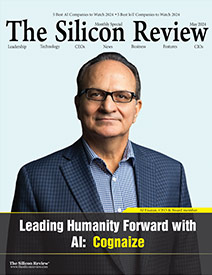>>
Industry>>
Food and beverages>>
Tech Innovations Reshaping Foo...Tech Innovations Reshaping Food Regulation: The Rise of Nutrition Label Makers
The Silicon Review
29 April, 2024
For a very long time, consumers have faced numerous challenges in understanding the cryptic world of food labels. These labels are often densely packed with technical terms written in microscopic font sizes, making it difficult to understand the nutritional contents of various foods.
The good news is that a new wave of technological innovations is emerging, complete with new tools redefining how food regulations are met and, perhaps more importantly, understood by everyday consumers.
This article explores the recent rise in nutritional label makers that completely transformed food regulation compliance.
Food label makers are shaking up the food industry by:
1. Simplifying Compliance for Food Manufacturers
In the past, food manufacturers have found adhering to labeling regulations quite complex and time-consuming, especially for smaller food producers.
This is largely because manually calculating nutritional information, deciphering ingredient breakdowns, and remaining compliant with ever-changing formatting requirements can be difficult. Regulations often vary depending on the product type, country of origin, and intended market, among other pertinent factors.
Now, this is where nutrition label makers come in. They act as one-stop shops that food producers can use to streamline the compliance process by accessing benefits that include:
Automated calculations
Nutrient analysis is often considered the most formidable part of creating a label. A nutrition label maker works by integrating with comprehensive databases containing thousands of ingredients' nutritional profiles.
All producers have to do is simply input their recipe, and the platform will automatically calculate the total fat, carbohydrates, protein, vitamins, and minerals found in the final product.
This eliminates the need for manual calculations, thus reducing the risk of errors while saving valuable time.
![]()
Label formatting
Thanks to label makers, Consumers no longer struggle with tiny font sizes and confusing layout templates. They provide user-friendly interfaces with pre-designed label templates that automatically fill in with the calculated nutritional information.
Such tools allow compliance with mandated formatting regulations, reducing the risk of rejected labels and costly delays.
Ingredient breakdowns
Food sensitivities and allergies are on the rise. Because of this, food label makers now have the technology to automatically identify potential allergens in a recipe and highlight them on the label in a clear, consistent format.
This makes it easier for manufacturers to comply with allergen labeling requirements and gives consumers the information they need to make dietary choices.
2. Empowering transparency for consumers
Food label makers do more than just empower producers; their true power lies in their ability to simplify consumers' lives. Here’s a breakdown of how they are changing how people interact with food labels.
Translating complex information
Food label makers translate complex nutritional data into clear, concise, and visually appealing formats that average consumers can understand.
They come up with labels highlighting important information such as sugar content, fiber content, or suitability for specific dietary preferences such as vegan and gluten-free.
This helps consumers understand the nutritional value of a food product quickly and, after that, make informed choices that align with their dietary restrictions or personal health goals.
![]()
Interactive label experiences
Label makers are exploring using augmented reality (AR) technology to create interactive label experiences.
Consumers could simply scan a label with their smartphones to access more information about a product or even watch a video showcasing the recipe. This fosters trust between consumers and food manufacturers.
3. Facilitating Innovation in the food industry
The food industry is dynamic, with constant changes, including new ingredients, processing techniques, and formulations. This challenges food regulation, as keeping up with such rapid innovation may be difficult.
Here’s how food label makers contribute to innovation within the framework of existing regulations.
Up-to-date databases
Regulatory databases become outdated once new ingredients hit the market. Label makers keep up with industry trends and continuously update their databases with nutritional profiles of new ingredients, enabling producers to label all of their products accurately.
Regulatory Flexibility tools
Label makers have features that enable food manufacturers to explore various formulation options while remaining compliant with industry regulations. For example, they may let producers experiment with different ingredient combinations and instantly observe the impacts.
Conclusion
Tech innovations like nutrition label makers are reshaping the world of food regulation, offering improved transparency, accuracy, and efficiency in food labeling.
Manufacturers can take advantage of this and safely navigate the complexities of regulatory compliance with confidence while at the same time providing their consumers with all the information they need to make important choices about their food.
Food label makers will drive a positive change in the food industry.









